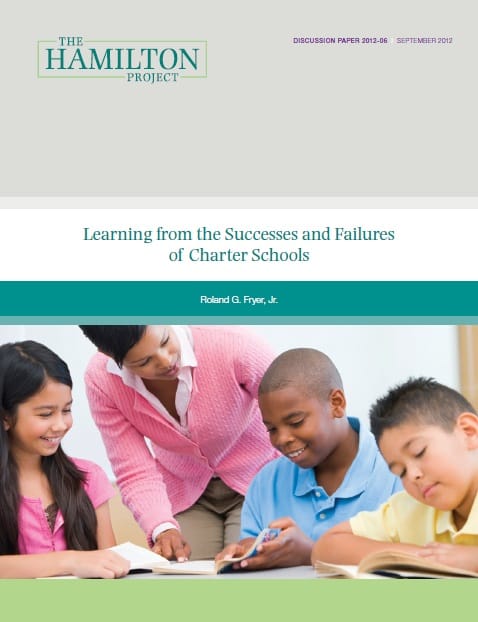 Charter schools—“exceedingly rare laboratories” for educational innovation—have much to teach the traditional district sector, explains Harvard economist cum MacArthur “genius” awardee Roland Fryer in this paper for the Brookings Institution’s Hamilton Project. Drawing upon his recent evaluation of charter schools in New York City, Fryer offers five educational practices that explain nearly half of the achievement difference between high- and low-performing charters: 1) a focus on human capital (weekly teacher-development sessions, for example); 2) the use of data to drive (and personalize) instruction; 3) the provision of high-dosage tutoring (targeted based on data-driven analyses); 4) the extension of time on task (by lengthening the school day and year); and 5) the establishment of a high-expectations culture. Profiling Houston and Denver, Fryer then explains how this package of reforms may be brought to scale—and what the marginal cost for implementing each would be. Overall, Fryer estimates a $6 billion price tag to avail the 3 million students in the nation’s 5,000 lowest-performing district schools of this reform package. Though this sticker price may be negotiable. For example, Fryer’s budget doesn’t address how technology could be exploited to lower long-term costs (think: tutoring). And, as he asserts in the paper: “While costs may vary by school, one thing is clear: High expectations are free.”
Charter schools—“exceedingly rare laboratories” for educational innovation—have much to teach the traditional district sector, explains Harvard economist cum MacArthur “genius” awardee Roland Fryer in this paper for the Brookings Institution’s Hamilton Project. Drawing upon his recent evaluation of charter schools in New York City, Fryer offers five educational practices that explain nearly half of the achievement difference between high- and low-performing charters: 1) a focus on human capital (weekly teacher-development sessions, for example); 2) the use of data to drive (and personalize) instruction; 3) the provision of high-dosage tutoring (targeted based on data-driven analyses); 4) the extension of time on task (by lengthening the school day and year); and 5) the establishment of a high-expectations culture. Profiling Houston and Denver, Fryer then explains how this package of reforms may be brought to scale—and what the marginal cost for implementing each would be. Overall, Fryer estimates a $6 billion price tag to avail the 3 million students in the nation’s 5,000 lowest-performing district schools of this reform package. Though this sticker price may be negotiable. For example, Fryer’s budget doesn’t address how technology could be exploited to lower long-term costs (think: tutoring). And, as he asserts in the paper: “While costs may vary by school, one thing is clear: High expectations are free.”
SOURCE: Roland G. Fryer, Jr. Learning from the Successes and Failures of Charter Schools (Washington, D.C.: Hamilton Project at the Brookings Institution, September 2012).
